What is white corn, how does it differ from ordinary corn and how to eat it
Both adults and children love corn. It contains a lot of useful trace elements, and it is not only eaten, but also used in medicine.
In the article, we will take a closer look at what white corn is, what is its composition, how it differs from yellow corn, where and how it is used in medicine and how to grow it correctly.
The content of the article
What is White Corn
This is a plant that has an ear, inside which there are a large number of white seeds. Thanks to the many years of work of breeders, more than two thousand of its varieties are known in the world.... It is not only white, but also yellow, and also with colored grains.

She was brought to Russia from South America... It has gained popularity among European residents due to its soft structure and grains, which have a sweet and pleasant taste. The most common in Russia is the yellow variety, but the white one is rapidly overshadowing its "relative".
Feature and Description
Outwardly, all varieties of corn are similar, the only difference is the color of the grains... White has a powerful stem, which reaches a height of 1.5-2.5 m. Leaves are light green, similar to long ribbons.
The leaf plate grows up to 10 cm wide... The rhizome of the culture is well developed, consists of a lobe and a number of growing roots. It differs from other varieties in white grains on the cob. The average weight of one ear reaches 200-300 g.
Attention!Due to its sweetish taste and soft structure, white corn is consumed not only raw, but also boiled, used for conservation.
Composition
White corn contains a large number of trace elementsthat have a positive effect on the human body. The ears contain an easily digestible protein. Grains contain more vegetable protein than other grains.
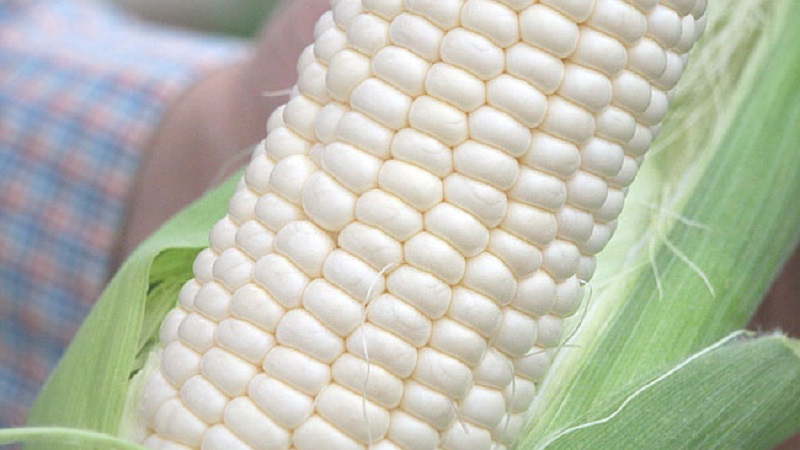
This protein is essential for people who have completely eliminated meat products from their diet. It is absorbed faster by the body than found in meat.
Grains contain such beneficial trace elements and vitamins:
- PP;
- A;
- B1;
- B9;
- E;
- D;
- TO;
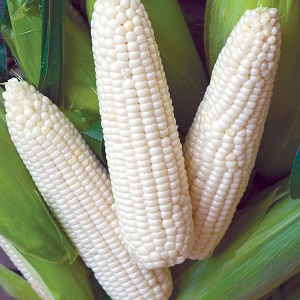 choline;
choline;- beta carotene;
- carotenoids;
- potassium;
- phosphorus;
- sulfur;
- magnesium;
- chlorine;
- calcium;
- magnesium;
- boron;
- vanadium;
- titanium;
- selenium;
- tin;
- manganese;
- chromium.
Interesting on the site:
The difference between white corn and yellow corn
Most white corn varieties are sweet varieties, and the yellow one is often used for the preparation of feed mixtures, oils, etc. White varieties are harvested unripe, yellow ones - only ripe.
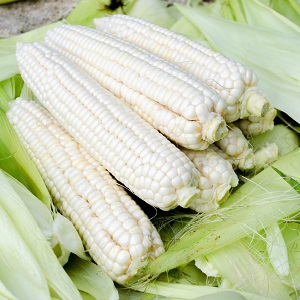 White is the result of a mutation of yellow, in which the ratio of sugar is several times greater than that of starch. Sweet corn is mainly consumed fresh or after being treated with boiled water.
White is the result of a mutation of yellow, in which the ratio of sugar is several times greater than that of starch. Sweet corn is mainly consumed fresh or after being treated with boiled water.
When white corn grows on a stem, it curls into layers of green and white husks.... Its grains contain more water than yellow varieties. The grains and milk that are present in it have the same color, while in yellow they are yellowish.
As they ripen, the grains of white corn also become tough and hard., which is associated with a decrease in the amount of water in the cores. Yellow contains more nutrients and nutrients than its white counterpart. It contains lute and other trace elements that its white "brother" does not have.
Seeds
For cultivation in the white corn plot select several already planted and healthy bushes in order to collect seed from them in the future. It is better to choose the cobs for the seeds, which were among the first to appear on the bush, and cut off the remaining ovaries with a pruner so that they do not take away the strength of the seedling. In this case, all useful components will accumulate only in this cob.
To get quality seed, pay attention to the maturity of the grains. White corn is consumed fresh, but this is not suitable for breeding - you need to wait for its biological maturity. It is not difficult to understand that the corn is ripe - it happens in September.

White corn suitable for collecting seed if:
- its stem and foliage dry up and turn yellow;
- the grains become hard, and when pressed on them, no milk is released.
Beneficial features
People who eat white corn regularly report improved well-being and appetite... The microelements included in its composition (magnesium, sodium, calcium, fluorine, etc.) are indispensable for the full functioning of the cardiovascular and musculoskeletal systems of a person, and carotenoids are for eye health.
Corn porridge and young cobs of the plant are considered useful.... They also use a canned product, only when buying, pay attention to the expiration date.
White corn has a positive effect on the body:
- helps to cope with anemia;
- improves digestion;
- promotes the full growth and development of the child;
- cleans blood vessels;
- helps to cope with nervous disorders and stress;
- increases reproductive function in women and men;
- slows down the aging process of the skin, removes skin pigmentation.
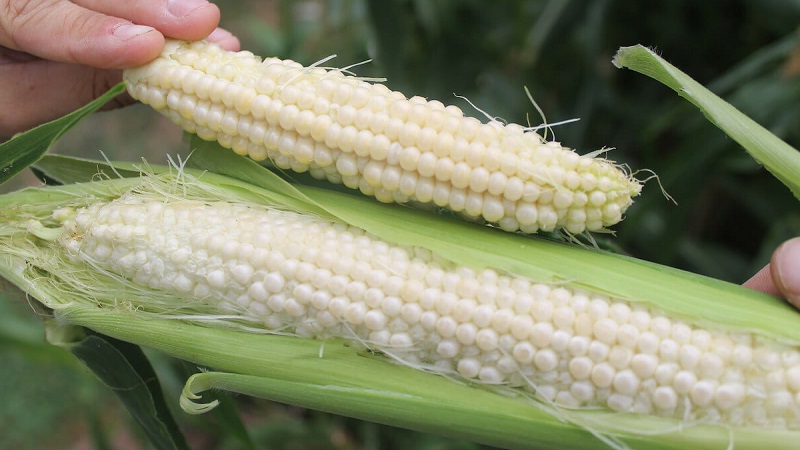
Growing features
It is recommended to grow white corn in loose soil with good air and moisture permeability. The plant needs feeding and fertilization, especially at the time of ear formation. Seeds are planted in the soil only after the ground warms up to a depth of + 10 ° C.
At a lower temperature, seedlings appear spontaneously, and sometimes completely rot in the ground, never sprouting. White corn does not need daily watering, it thrives in dry and hot weather. It is better to sow seeds in a well-lit place, then both the leaf blade and the cobs will form faster, and the yield will be much higher.
The best varieties
The most popular varieties of white corn are:
- Mermaid... This is a mid-season variety. It grows in height 170-190 cm, has a cone-shaped ear. Weight of one - 200-350 g. This variety perfectly tolerates drought and disease resistance.
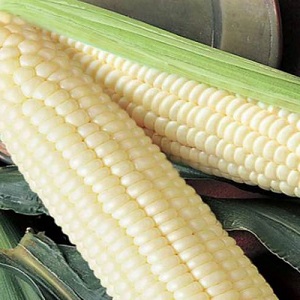 Snow White (on the picture). An early variety, the ear ripening occurs 73–80 days later. The bush reaches a height of 2 m. The ears are cylindrical, 15–20 cm long, weighing 200–300 g. The grains are deep white.
Snow White (on the picture). An early variety, the ear ripening occurs 73–80 days later. The bush reaches a height of 2 m. The ears are cylindrical, 15–20 cm long, weighing 200–300 g. The grains are deep white.- The Snow Queen... Its features are non-standard ear size and high yield. This variety is mid-season, it takes 90-100 days to ripen the fruit. The ears are cylindrical in shape, grow up to 35 cm in length, and each weighs more than 300 g.
- Medunka... It belongs to early maturing varieties of white corn, ripens in 70–75 days. The bush reaches a height of 2 m, the shape of the cobs is cylindrical, the weight of each fruit is 200–300 g. Medunka perfectly tolerates temperature changes and heat.
Application
White corn eaten, raised for livestock feed, made into butter... It is also used in cosmetology, animal husbandry and industry.
In cooking
White corn is loved and consumed all over the world:
Also it is used to make flour, butter and starch.
In folk medicine
White corn is used in folk medicine:
- used as a choleretic agent;
- as part of drugs to stop bleeding;
- in the form of an infusion for liver diseases;
- for weight loss and in the fight against obesity;
- in the treatment of diabetes mellitus, pancreatitis and urolithiasis.
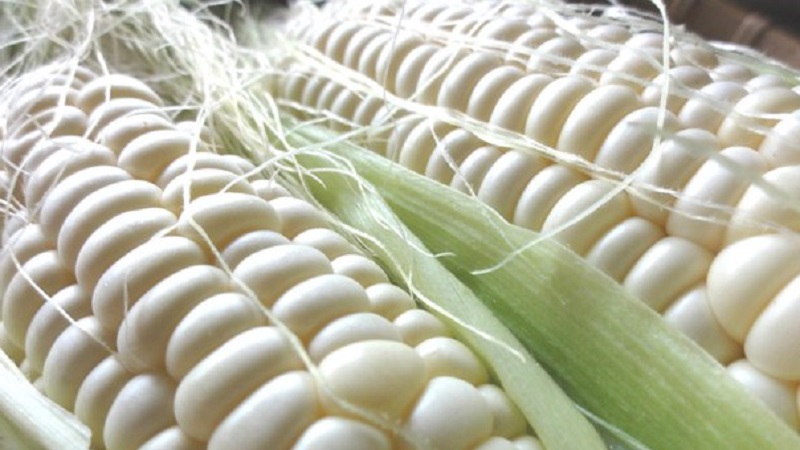
Contraindications
If corn is placed in a tin can, water and iron react inside... With the regular use of such a product, the work of internal organs is disrupted. Hepatitis, cirrhosis, diabetes, arthritis and malignancy can develop.
Doctors it is not advised to eat white corn for people suffering from:
- thrombosis and increased blood clotting;
- individual intolerance to the components;
- gastrointestinal diseases - gastritis, stomach ulcer;
- obesity.
It is not recommended for people who monitor weight and are on a diet to consume corn in any form... She is considered high-calorie product: 100 g contains 90 kcal.
Conclusion
White corn has a pleasant sweetish taste. It is consumed raw, boiled and canned. Due to the content of vitamins and microelements, the product is widely used in folk medicine, cooking and animal husbandry.